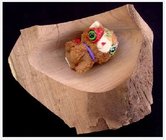I'm a Powercap user as well. I was pretty good about using a Uvex but had limited patience for facemasks. I can wear the thing all day at the respirator feature is phenomenal. But I do bear in mind that that the face sheild is impact "resistant" and the cap is a bump cap and not a hard hat so I also focus hard on where I stand and what I'm turning.
-
December 2025 Turning Challenge: Single Tree! (click here for details) -
Congratulations to Bob Henrickson, People's Choice in the November 2025 Turning Challenge (click here for details) -
Congratulations to Guillaume Fontaine for "Old Tea Pot" being selected as Turning of the Week for December 15, 2025 (click here for details) -
Welcome new registering member. Your username must be your real First and Last name (for example: John Doe). "Screen names" and "handles" are not allowed and your registration will be deleted if you don't use your real name. Also, do not use all caps nor all lower case.
Face Shield part 2
- Thread starter Michael Nathal
- Start date

